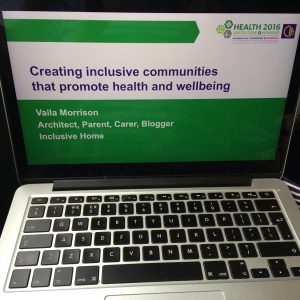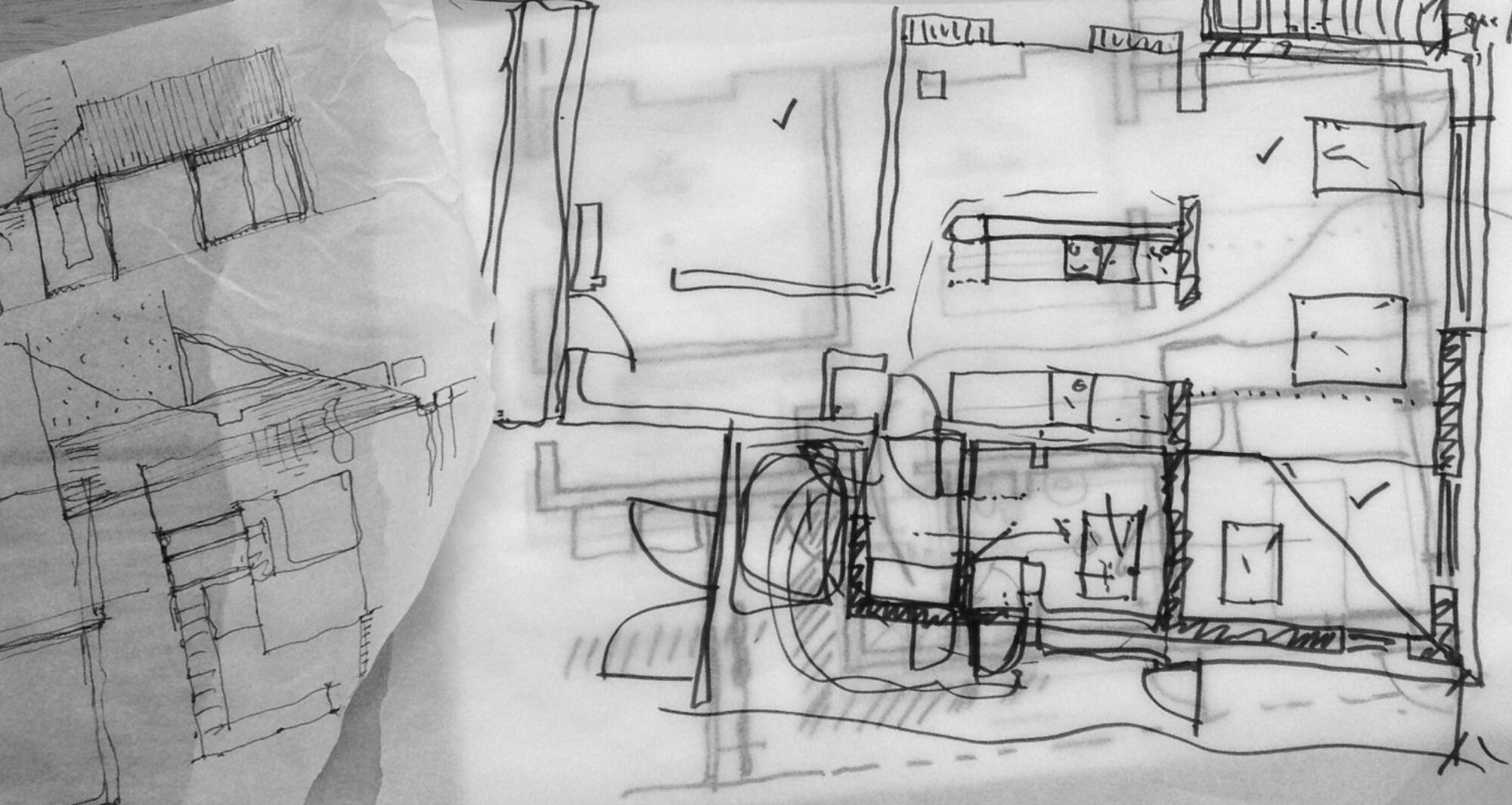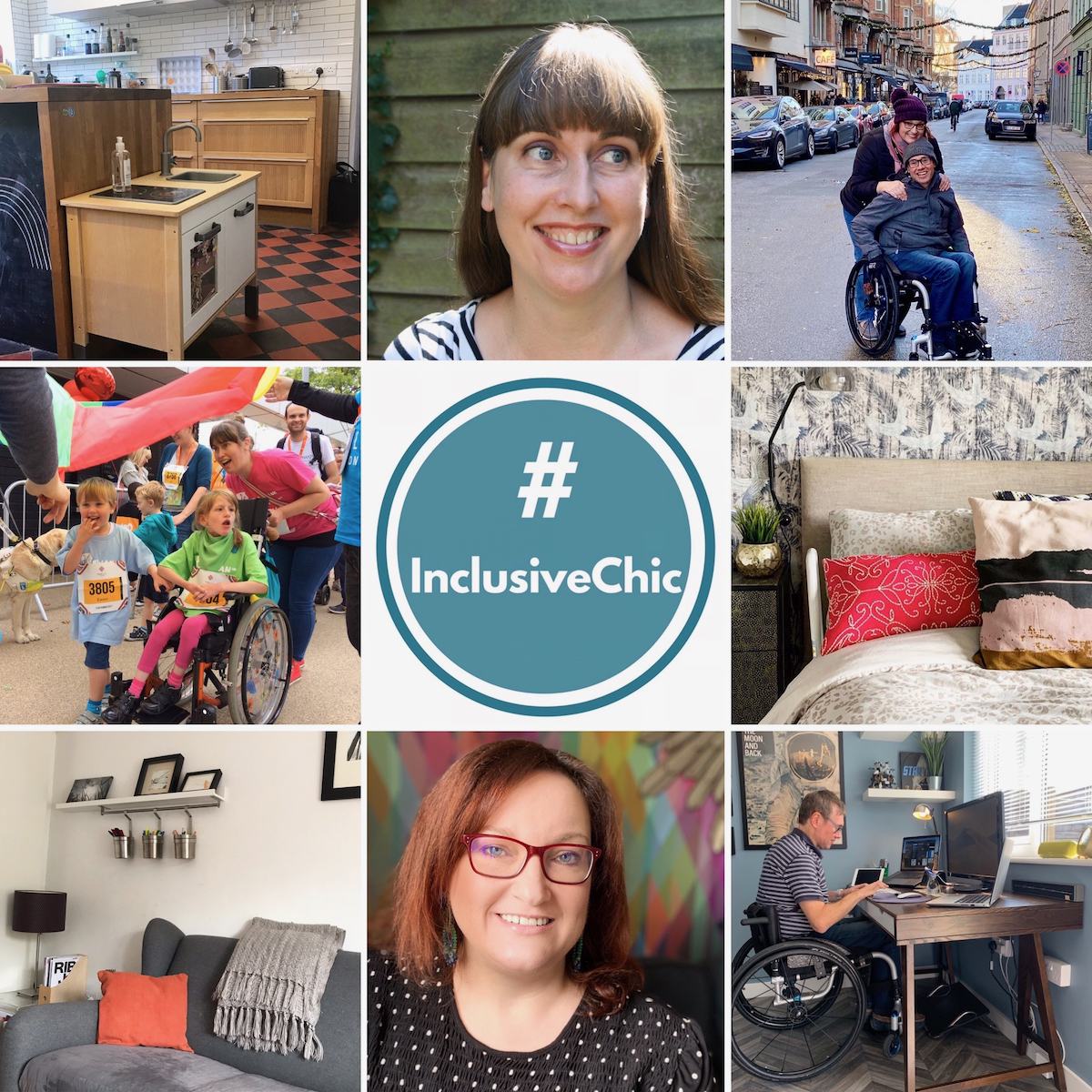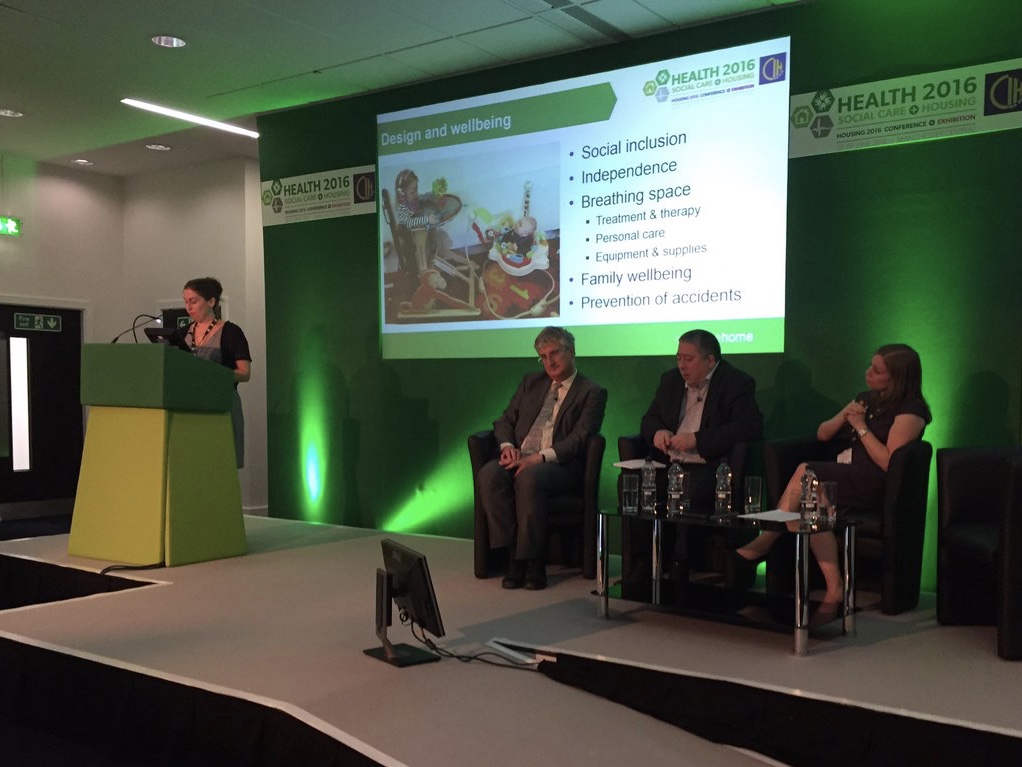talking of home
I gave a short talk at the Health, Social Care & Housing conference last week! One of a series of sessions running parallel with the main Chartered Institute of Housing Conference in Manchester from 28-30th June (#CIHhousing16).
 It’s totally out of my comfort zone, but raising awareness of inclusive & accessible housing is such an important issue to me that when Habinteg kindly asked me to join them in a talk, I just had to say yes!
It’s totally out of my comfort zone, but raising awareness of inclusive & accessible housing is such an important issue to me that when Habinteg kindly asked me to join them in a talk, I just had to say yes!
Habinteg are champions of accessible design and are one of the founders, and now maintainers, of Lifetime Homes standards (the widely used inclusive design standards for housing). Habinteg’s Paul Gamble chaired the session, which examined the links between accessible housing and the pressures in social care. The two other speakers were researcher Martin Wheatley (@wheatley_martin) and Michelle Horn from Centre for Accessible Environments.
Martin presented highlights from the new research he’s been carrying out (involving Habinteg, Papworth Trust, IPSOS Mori & LSE), trying to identify and quantify the REAL need for accessible housing. Such a difficult area to pin down as not all people who need increased accessibility necessarily identify themselves as disabled, and/or may not be ‘in the system’, so even these new results could be an underestimate of the real need. (And of course that’s putting aside the fact that although every family doesn’t ‘need’ their home to be accessible right now, every family, at any point in time, could need their home to be more accessible for themselves or for their wider friends and family).
Some really interesting findings were presented, which could help give context to, and generate a more widespread appreciation for, the value of inclusive and accessible design in the mainstream. The two findings that excited me most were:
- Disabled people are not mostly old people! Martin’s stats showed that over 50% of disabled people are working age people or children. I think this is really important for design, because often the perception of accessibility is ‘old age’ and this often takes the style and glamour out of it! (Not that I’m saying older people are not stylish and glamourous you understand! I know many who are! – but there does seem to be a hint of the industry not trying very hard when it comes to design + old age.
- Accessiblity features don’t put house buyers off! I think this is huge! Part of the research was a survey of a typical cross section of society (with a broadly proportionate number of disabled & non-disabled people). The question was broken down into elements (broadly similar to the lifetime homes categories) and most were seen as an advantage rather than disadvantage. It was just the very specialist items, like vertical lifts, that were deemed were off-putting (presumably to those who didn’t need them!). I think this is really valuable information to help demonstrate the desirability of accessibility!
Michelle talked of our existing housing situation in the uk. For example, at present only 6% of our homes have even the basic accessibility features, in line with the new ‘visitable’ building regulations standards (Part M: Category 1). So even if we were building 100% of homes to lifetime homes standards (or Part M: Category 2), it’s going to take us a very long time to reach anywhere near enough to house the current estimate of 20% of families with a member who has access needs. And if we are to continue on our current trajectory, only providing 10% of wheelchair accessible housing in our newbuild developments, there’s no doubt that more expensive (and disruptive) adaptations will continue to be necessary to existing properties.
 My own contribution to the talk was one of two halves. Firstly our own home story, told from a family perspective, what ‘making do’ actually means for us and what we plan to do to our house – you can read part one of my talk on Habinteg’s blog.
My own contribution to the talk was one of two halves. Firstly our own home story, told from a family perspective, what ‘making do’ actually means for us and what we plan to do to our house – you can read part one of my talk on Habinteg’s blog.
The second half was more of a call to action – How do we shake the perception that accessibility is niche? That there isn’t inclusive design & normal design, that if society is really serious about inclusion and equality, then shouldn’t all design be inclusive? Edited to add: Habinteg have posted part two on their blog too.
I’m so glad I took part in the talk. It was great to meet & chat to the other speakers and we had some lovely feedback from people who attended.
Habinteg are following up with a day of action on Friday 8th July!
Do get involved on twitter with the #ForAccessibleHomes hashtag!
design that cares
It’s Carers week 2015 in the UK so I thought I’d write a little bit about us and about the difference a ‘care friendly’ home would make.
We are all on different journeys to become carers, for some it is a sudden occurrence (through accident or sudden illness), but for most (I think?) it’s a very gradual thing.
 We didn’t know EJ was going to have additional needs when she was born, her neurological condition only gradually revealed itself to us. She’s now 4.5 and is non-verbal with very limited communication and understanding, is mobile in a sort of bunny hop/bumshuffle fashion, can stand and take a few steps with support but is a long way from walking (if she ever does?). I still feel a bit weird about the term carer as it applies to me – I’m a mum, and being a mum to any child is being a carer – isn’t it? However I can see that the older EJ gets, the more I will fit into the role of parent carer. My days continue to involve a lot of guessing what she needs/wants, nappy changing, help with eating, lifting, oh and hugs! Lots of hugs!
We didn’t know EJ was going to have additional needs when she was born, her neurological condition only gradually revealed itself to us. She’s now 4.5 and is non-verbal with very limited communication and understanding, is mobile in a sort of bunny hop/bumshuffle fashion, can stand and take a few steps with support but is a long way from walking (if she ever does?). I still feel a bit weird about the term carer as it applies to me – I’m a mum, and being a mum to any child is being a carer – isn’t it? However I can see that the older EJ gets, the more I will fit into the role of parent carer. My days continue to involve a lot of guessing what she needs/wants, nappy changing, help with eating, lifting, oh and hugs! Lots of hugs!
In my ideal world we’d already live in an accessible home, or at least one built to inclusive design standards like lifetime homes. When we bought our house it was more a matter of finding something we could actually afford in an area that my husband could commute to work from! The house we have is the only one we found that fitted those categories (it only fitted the affordability category as it needed quite a lot of TLC!) – but, it is not accessible.
We, like so many others, are ‘making do’ in an unsuitable house (for other people’s stories see Leonard Cheshire’s #Hometruths campaign).
We could move – but there is a real lack of accessible housing on the private sale market and almost zero on the private rental market.
We could join the council housing/housing association list – but again there’s a distinct lack of available properties and therefore any that come up are in extremely high demand.
Or finally, (and this is the route we are going down) we could adapt. (We are very grateful that there is some financial support for this in the form of the Disabled Facilities Grant, but it is a long process and, of course, is a limited sum – so to meet Twinkle’s needs our project will involve partially self funding – ie borrowing more!).
None of our options would be a quick fix, and most would involve a large amount of upheaval, stress and cost – something that people finding themselves needing care or in a caring role can little afford – and for that reason, many just struggle on continuing to try and ‘manage’ with what they have.
Unfortunately the house building industry often seems to pigeonhole design very much as ‘wheelchair friendly’ or ‘normal’. But what is ‘normal’!?
If you think about it, everyone begins life ‘disabled’! We’re not born walking, most of us begin life ‘on wheels’! Many of us will also end life with reduced mobility (not to mention the whole spectrum of conditions between cradle and grave that could affect our use and enjoyment of our homes (sight, hearing, dementia…..). To me it just seems wasteful and unsustainable not to design homes to allow for this transition as easily as possible!
Some councils, have adopted a standard called Lifetime Homes for new houses. It is meant as exactly that. It doesn’t have to be fully wheelchair accessible from the start, but that the fundamentals of the design should consider a whole lifetime’s needs. The house, and access to it, follow a checklist of features that would make life much easier for a disabled or elderly resident or visitor (and therefore also for those caring for them). The design should also take into account how it could be adapted in the future if needed (e.g. where lifts or hoists could be positioned for the greatest benefit and least impact on the rest of the family).
I would love to see this standard adopted nationally for new housing. It would ease so much pressure (both mental and physical!) for people if their home accommodated them easily, no matter their ability, without having to go through disruptive changes at a difficult time in their lives (not to mention helping free up space in hospitals if people can more easily return to their own homes!).
But the scope shouldn’t just be new houses! Like us, most people live in a ‘2nd hand house’! What I’d like to see is more inspiration and information out in the mainstream media about the benefits of inclusive and accessible design for everyone. There is the occasional article in the mags or a feature on home design TV shows, and (of course!) there is the gold standard – DIYSOS Big Build – who do amazing work! However generally these features tend to include a disabled family member. How often is there any mention of accessibility or inclusion otherwise? So often when these TV shows start off, the family is young and able, with no children (or pregnant, so many of them are pregnant!), building a home for their new family life – how fab would it be to discuss inclusive design in this context – a home that’s easily adaptable for whatever life throws at you?!
We need a change in perception! We need to get people thinking about how their home can be comfortable for the long haul? Consider flexibility for the future!
I understand that it may seem a bit depressing to be talking about degenerative health when you embark on a new and exciting house project, but inclusive design is not just about illness, disability and old age. Inclusion is about multi-generations. It’s about children, people with bikes to store, being able to get big furniture into the house without taking out a door frame! It’s about well considered planning. You only have to watch a few episodes of Grand Designs or read a few interiors and house design magazines and to see that people are aspiring to lovely wide open plan spaces, level garden decks etc – lots of things that are completely compatible with inclusive design. Nothing makes achieving wheelchair turning circles easier than minimizing narrow corridors and gaining more open plan living space! Lifetime homes/design for all needs is just an extension of what people are already moving towards. With an extra layer of thought added: Where would a vertical lift go if one was needed in the future? Would a room downstairs be able to become a bedroom? What about wheelchair storage areas (also useful for bikes, buggies, kids trikes/scooters) or the downstairs loo big enough to fit a wet floor shower (- and how useful for hosing down muddy kids and dogs too!)?
We are all willing to take out insurances to protect our fincances when we buy a home, so why not consider our future needs in our home when making a big investment like an extension and/or refurbishment? I think people would be open to consider these ideas were they made aware of the the benefits and offered inspiration!
I think a lot can be learned from the way that improvements in energy efficiency performance has moved up the agenda in recent years. An Eco home is now a sellable feature so why shouldn’t inclusive sit proudly alongside eco on that estate agents brochure!?




